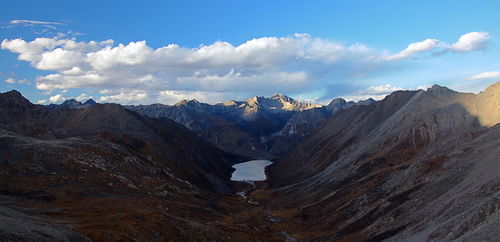Dakpo: Difference between revisions
Jump to navigation
Jump to search
Yeshedorje (talk | contribs) mNo edit summary |
(Tibetan.) |
||
| Line 1: | Line 1: | ||
[[Image:Lhamo Lhatso.jpg|thumb|500px|Lhamo Lhasto, in the Dakpo region, courtesy of Tibet Wind Horse Adventure]] | [[Image:Lhamo Lhatso.jpg|thumb|500px|Lhamo Lhasto, in the Dakpo region, courtesy of Tibet Wind Horse Adventure]] | ||
'''Dakpo''' ( | '''Dakpo''' (Tib. དགས་པོ་, Wyl. ''dags po'') is one of the three main regions comprising '''South Eastern Tibet'''. The region is a central location for practitioners associated with [[Gampopa]] and his lineage, the [[Dakpo Kagyü]]. | ||
In the 14th century, [[Karma Lingpa]] discovered in Dakpo his famous cycle of the [[Zabchö Shitro Gongpa Rangdrol]], which includes the [[Tibetan Book of the Dead]]. Among the great masters who were born in Dakpo is the [[13th Dalai Lama]]. | In the 14th century, [[Karma Lingpa]] discovered in Dakpo his famous cycle of the [[Zabchö Shitro Gongpa Rangdrol]], which includes the [[Tibetan Book of the Dead]]. Among the great masters who were born in Dakpo is the [[13th Dalai Lama]]. | ||
Revision as of 06:18, 27 April 2017

Dakpo (Tib. དགས་པོ་, Wyl. dags po) is one of the three main regions comprising South Eastern Tibet. The region is a central location for practitioners associated with Gampopa and his lineage, the Dakpo Kagyü.
In the 14th century, Karma Lingpa discovered in Dakpo his famous cycle of the Zabchö Shitro Gongpa Rangdrol, which includes the Tibetan Book of the Dead. Among the great masters who were born in Dakpo is the 13th Dalai Lama.
Dakpo is also home to the famous Lhamo Lhatso lake, related to Palden Lhamo.